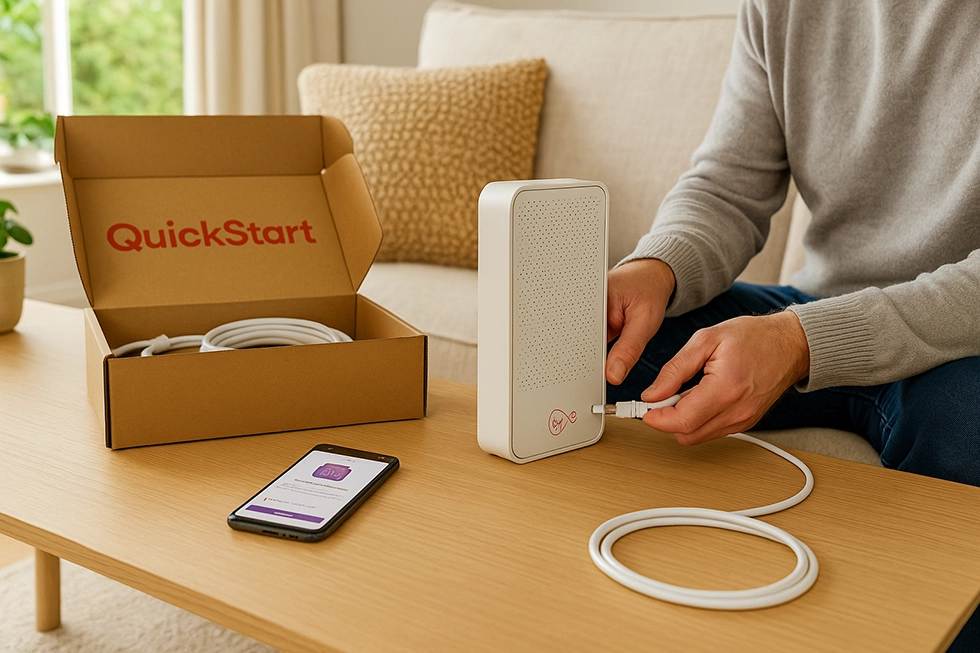Virgin Media Gig1 Fibre Broadband Review

Virgin Media Gig1 is one of the fastest broadband options you can get in the UK – and unlike some full fibre options, it’s available in many areas across the country.
You’ll get an average download speed of 1,130Mbps and an upload speed of 104Mbps, which is more than enough for just about everything, from HD streaming and large downloads to heavy online gaming.
Virgin Media Gig1 Broadband Details
- Average download speed: 1,130Mbps
- Average upload speed: 104Mbps
- Estimated download speed : 565–1,136Mbps
- Estimated upload speed : 52–104Mbps
- How many devices: 10+ devices
- Minimum guaranteed download speed: 565Mbps
- Network technology: Virgin Media cable (DOCSIS) / XGS-PON in full fibre areas
- Latency range: 10–20ms
- Available package options: Broadband only, broadband + phone, broadband + TV, Volt bundles with an O2 SIM
- Router: Hub 5 (DOCSIS 3.1) or Hub 5x (XGS-PON)
- Wi-Fi standard: Wi-Fi 6
- Contract length: 24 months
- Price range: £25 to £45
- Optional extras: WiFi Max, call features, TV add-ons, Volt bundles
Today’s Offers
| Plan | Speed | Price | |
|---|---|---|---|
 Gig1 Fibre Gig1 Fibre24 month contract |
1130Mb avg |
£30.99 / month £371.88 / year More details |
 |
| FTTP. Free Setup. Voucher offer ends 18th December. | |||
 Gig1 + Phone + Netflix Gig1 + Phone + Netflix24 month contract |
1130Mb avg |
£41.99 / month £503.88 / year More details |
|
| Free Setup. Includes Anytime calls to UK landline and mobiles. |
Virgin Media Gig1 Broadband Speeds
Download speed (1,130Mbps)
This is where Gig1 really shines. It’s ridiculously fast—1,130Mbps on average, which means you can download a full 10GB file in about a minute. That’s a massive game update or 4K film sorted before you’ve even made a cuppa. And because there’s loads of extra bandwidth, it doesn’t slow down when a few people are using it at once.
Here’s what that kind of speed looks like in real life:
- 10GB file – 1 minute
- 25GB 4K film – 3 minutes
- 50GB game update – 6 minutes
- 100MB music album – blink and you’ll miss it (1 second)
Virgin Media download time comparison
Upload speed (104Mbps)
Most broadband plans skimp on upload speeds, but not Gig1. You get a fully 104Mbps upload speed, which is ideal if you back up files to the cloud, send large files for work, or do a lot of video calls. Even with a few people uploading at once, it stays quick.
Upload times at 104Mbps:
- 1GB file – 1 minute 20 seconds
- 2GB folder of photos – 2 minutes 40 seconds
- 5GB video file – just over 6 minutes
Virgin Media upload time comparison
Latency (10–20ms)
Latency (or ping) is how fast your connection reacts—super important for gaming and video calls. Virgin’s Gig1 normally sits in the 10–20ms range, which is fine for most things. It’s not the absolute lowest out there, but still decent.
If you’re serious about gaming, plugging into the Hub with an Ethernet cable will keep things snappy. Wi-Fi can add a bit of delay if you’re far from the router or there’s a lot going on.
Here’s how it stacks up against the competition:
- Virgin Media: 10–20ms
- BT Full Fibre (Openreach): 6–8ms
- Community Fibre: 2ms
- Hyperoptic: 4–5ms
Virgin Media Gig1 Broadband Deals
Virgin Media Gig1 is available in a range of bundle options. You can choose a straightforward broadband-only plan or go for a more complete package that includes a home phone, a wide selection of TV channels, and even an O2 SIM, depending on your needs.
Gig1 Broadband Only
This is the simplest option—just fast broadband and a Hub to go with it. No phone line, no TV, no fluff. Great if you just want high-speed internet without paying for stuff you won’t use.
What you get:
- Virgin Media Gig1 broadband
- Hub 5 or Hub 5x
- WiFi Max included with volt bundles
- Netflix Standard with ads included on selected bundles
Gig1 Broadband + Phone
If you need a home phone, this option includes Virgin Media’s digital phone service. It comes with unlimited calls to UK landlines and mobiles, subject to fair usage terms.
What you get:
- Gig1 broadband
- Virgin Phone
- Anytime Chatter plan (unlimited UK calls)
Gig1 Broadband + Flex TV
This option is well suited to those who want access to live TV and streaming apps without committing to a long-term TV contract. It includes a Virgin Stream or Flex box that brings everything together in one place.
What you get:
- Gig1 broadband
- 150+ TV channels
- Stream/Flex TV box included
- Access to apps like BBC iPlayer, ITVX, Channel 4, YouTube, and more
Gig1 Broadband + TV packages
Virgin Media also makes Gig1 available in comprehensive TV bundles. These packages include extensive channel selections, a dedicated TV box, and access to Netflix Standard with ads.
Below are the bundle options currently available:
Entertainment + Netflix
- 200+ TV channels
- Netflix Standard with ads
- TV box included
Cinema + Netflix
- Entertainment plus Sky Cinema in HD
Sport + Netflix
- Entertainment with Sky Sports in HD instead of movies
Volt Bundles (Gig1 + O2 SIM)
If you have, or are planning to get, an O2 Pay Monthly SIM, Virgin Media’s Volt bundles combine it with Gig1 broadband. While the speed stays the same, you’ll receive added benefits such as WiFi Max and extra features on your O2 mobile plan.
Virgin Media Hub Router and WiFi Max
When you sign up for Gig1, Virgin Media includes either the Hub 5 or the Hub 5x. Both are high-performance routers that support the latest features, including the current Wi-Fi standard, but each has a different set of specifications.
Hub 5x
The Hub 5x is provided in areas served by Virgin Media’s full fibre XGS-PON network. It’s the newest router in their range and is fully capable of supporting Gigabit-level connections.
Quick look at the specs:
- 7 antennas for better coverage
- Wi-Fi 6 – faster speeds, more devices, stronger signal
- 2.4GHz and 5GHz bands
- Ethernet: 1 x 10Gbps port + 3 x 1Gbps ports
- Guest network support
The router delivers the speed and capacity to manage everything from high-resolution streaming and large file uploads to uninterrupted gaming.
Hub 5
Customers on Virgin Media’s DOCSIS 3.1 cable network will be supplied with the Hub 5. While it shares many of the same features as the Hub 5x, it connects through a different network technology.
Specs include:
- Same 7 antennas and Wi-Fi 6 goodness
- Ethernet: 1 x 2.5Gbps port + 3 x 1Gbps ports
- Full support for Virgin’s fastest cable speeds
- Guest network included
WiFi Max
WiFi Max is Virgin Media’s way of making sure your signal reaches every room—and it’s included with eligible Gig1 deals.
Here’s what it offers:
- At least 30Mbps download speed in every room, guaranteed
- Up to 3 WiFi Pods included if you need extra coverage
- Still struggling after setup? You’ll get a £100 bill credit
The Pods plug into your sockets and extend your Wi-Fi around the house, so there’s no more signal dead spots or weak zones upstairs.
Virgin Media Hubs support modem mode, which means you can turn off their Wi-Fi functionality and connect your own router or mesh system. This is ideal for users who want to customise their setup or already use equipment like Google Nest or Eero.
Is Virgin Media Gig1 Worth It?
Gig1 delivers true gigabit speeds (1,000Mbps+) and is suitable for households where multiple people or devices are using the connection simultaneously. It comes with enough bandwidth to handle demanding tasks such as large downloads, high-definition streaming, gaming, and uploads without noticeable slowdown.
Where Gig1 does well
- Super fast downloads – with average speeds of 1,130Mbps, you’ll fly through big file transfers, game installs, and 4K films in no time
- Decent upload speed – 104Mbps is more than enough for backing up files, uploading videos, or working from home without hiccups
- Plenty of bundle options – go broadband-only or add TV, a phone line, or even mobile perks with Volt
- WiFi Max included – get a guaranteed speed in every room, and free WiFi Pods if your signal needs a boost
Where it could be better
- Upload speed is decent, but not symmetrical – 104Mbps is good, but it falls short of the symmetrical upload speeds you get with some other 1Gbps full fibre plans, like those from Hyperoptic or Community Fibre
- Latency isn’t the lowest – it’s fine for most people, but serious gamers might prefer the lower ping from full fibre providers like BT or Community Fibre
- Customer service could improve – Ofcom reports show Virgin gets more complaints compared to several other major providers, mostly about billing and resolving problems
- Long contracts – most deals lock you in for 24 months, which might be a bit much if you’re after flexibility
Verdict
Perfect for households that regularly stream, download, and upload, Gig1 offers the speed and performance needed when multiple people are online at the same time. It’s a good choice if your routine includes downloading large files, streaming in 4K across several devices, and relying on cloud services for work or backups.
For lighter users who mainly browse, check emails, or watch in HD, Gig1 may be more than you need.
Alternatives to Virgin Media Gig1
If you're comparing Gig1 with similar full fibre options, consider these:
- BT Full Fibre 900
- Vodafone Full Fibre 910
- Sky Full Fibre Gigafast
- Hyperoptic 1Gb Fibre
- Community Fibre 1Gb Fibre
FAQ
I use M500 — should I upgrade to Gig1?
Whether you should upgrade from M500 to Gig1 depends on how you use your broadband and what you want it to do.
Virgin Media M500 is already fast for many everyday tasks. It can manage HD streaming, web browsing, video calls, and large downloads at good speeds. Gig1 is much faster, with more capacity for both downloads and uploads.
Gig1 is a better choice if you regularly do things like:
- have multiple people online at the same time
- download very large files (games, high-res media, software)
- run several 4K streams simultaneously
- do regular cloud backups or upload large files for work
If your household mainly browses, uses social media, watches standard-definition video, and downloads occasionally, you may not see a significant day-to-day improvement from upgrading.
If M500 struggles when several devices are active, or you often wait for big downloads or uploads, Gig1 gives you extra speed and bandwidth that reduces slowdowns.
What is the upload speed of Gig1?
Gig1 offers an average upload speed of 104Mbps, which is much faster than Virgin Media’s slower packages.
The upload speed is not the same as the download speed, but 104Mbps is still more than adequate for most heavy users.
Which router will I get with Gig1?
The router you get depends on the type of network in your area.
- Hub 5x if you’re in a full fibre (XGS-PON) area
- Hub 5 if you’re on Virgin’s cable network (DOCSIS 3.1)
In day-to-day use, the two routers are very similar. Both use the Wi-Fi 6 standard, manage multiple devices well, and are capable of delivering gigabit broadband speeds.
Is Gig1 broadband good for gaming?
Yes. For most gamers, Gig1 is more than good enough. You get very fast downloads for game installs and updates, plus a reliable 104Mbps upload speed for online play, streaming, and video calls.
Latency (ping) is typically in the 10–20ms range. That works well for most online games. If you play competitively, some full fibre providers can offer lower latency, often in the 2–8ms range.
For the most consistent experience, use Ethernet rather than Wi-Fi, especially for consoles and gaming PCs. Wi-Fi can add extra delay if your device is far from the Hub or if your wireless channels are busy.
What network does Gig1 use?
Virgin Media Gig1 uses two network types, depending on where you live.
- DOCSIS 3.1 cable: Virgin’s cable network, available in many areas
- XGS-PON full fibre: a newer full fibre (FTTP) network, available in selected areas
Both networks can deliver gigabit speeds. Full fibre often delivers better performance for latency and upload, but Gig1 still has the same 1,130Mbps average download speed and 104Mbps upload speed.
Virgin Media uses its own network rather than the Openreach network used by providers like BT, Sky, and TalkTalk.
How is Gig1 installed?
Installation depends on whether your home already has a Virgin Media connection.
- If you’ve had Virgin before, setup is often quick. Virgin may send a self-install kit, and you plug the Hub in yourself.
- If this is a new installation, a Virgin engineer typically runs a line from the street to your home, sets up the Hub, and checks the connection. In full fibre (XGS-PON) areas, they install the fibre equipment as well.
The setup includes either the Hub 5 or Hub 5x, depending on your network. You’re usually online within a couple of hours once installation is complete.
Can I get Virgin Media Gig1?
Gig1 is widely available across the UK, often in more areas than many full fibre providers.
The quickest way to check is Virgin Media’s address-level availability checker. Enter your postcode, then select your exact property to confirm which packages and bundles are available.
Is Virgin Media customer service good?
Virgin Media’s customer service record is mixed. While the provider has made some improvements, Ofcom data indicates Virgin Media receives a higher number of complaints than several major providers, often linked to billing and how issues are resolved.
Many customers are happy with speeds and performance. Day-to-day support tends to attract more criticism. If service reliability and customer support are priorities, factor this in before you commit, especially as most Gig1 deals come with a 24-month contract.
How can I save money with Gig1?
You do not always have to pay the standard price shown on the provider’s website.
We often make exclusive deals available that you may not see when you go direct. These offers can include bill credits and price discounts.
What are Volt benefits and how do I get them with Gig1?
Volt gives you extra rewards when you combine Virgin Media broadband with an eligible O2 Pay Monthly SIM. If you’re on Gig1, you can still qualify for Volt benefits.
What Volt gives you:
- WiFi Max included, with Virgin’s WiFi guarantee and Pods if needed
- extra mobile data on eligible O2 plans (often doubled)
- O2 Travel Inclusive Zone roaming in 75+ countries on selected O2 plans
- priority access to certain upgrades and offers
How to get Volt:
- use an active O2 Pay Monthly SIM
- make sure you are the account holder for both O2 and Virgin Media
- once both services are active, Volt benefits are usually applied automatically within 14 days
If you already use O2, or you plan to switch, pairing it with Gig1 can add extra value.
What are the cancellation terms and mid-contract price rise rules?
Most Virgin Media broadband deals come with a 24-month contract. If you leave early, Virgin Media usually charges an early termination fee based on the months remaining and your monthly price.
If you move to a property where Virgin Media is not available, you may still need to pay to leave your contract early, unless Virgin agrees otherwise.
Price rises:
- Virgin Media includes annual price rises in its contract terms.
- If your contract started before 9 January 2025, the April rise is based on RPI plus 3.9%.
- For contracts from 9 January 2025 onwards, a fixed annual increase applies. Your contract documents confirm the amount.
- If the price rise is set out in your contract terms, you cannot leave without fees solely because that rise takes effect.
What is the difference between Gig1 and Gig2?
Gig1 and Gig2 are both ultra-fast Virgin Media broadband plans. Gig2 is a full fibre-only service with faster speeds, while Gig1 is the widely available gigabit option.
Gig1 is available on both Virgin Media’s cable (DOCSIS 3.1) and full fibre (XGS-PON) networks. Gig2 is limited to the full fibre (XGS-PON) network only, so availability is more limited.
| Feature | Gig1 | Gig2 |
|---|---|---|
| Download speed | 1,130Mbps (average) | 2,000Mbps (advertised) |
| Upload speed | 104Mbps (average) | 200Mbps (advertised) |
| Estimated download speed | 565–1,136Mbps | 2,060–2,085Mbps (peak times) |
| Estimated upload speed | 52–104Mbps | 209Mbps (peak times) |
| Minimum guaranteed download speed | 565Mbps | 1,000Mbps |
| Optional upload add-on | Not listed | 2,000Mbps upload speed (optional) |
| Router | Hub 5 / Hub 5x | Hub 5x |
| How many devices | 10+ active devices in a typical home | No fixed limit published; more extra capacity |
| Availability | 18.7 million premises | 7–8 million premises |











